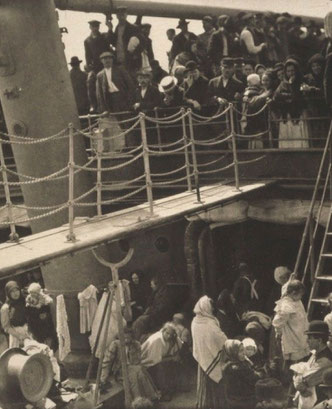-> -> American immigrants who returned to Europe <- <-

Alfred Sieglitz, “The Steerage,” 1907, http://en.wikipedia.org/wiki/The_Steerage
Iconic Irony
This image of transatlantic steerage passengers was the personal favorite of the man who took the picture in 1907, Alfred Stieglitz, "arguably, the most important photographer of his time" (Encyclopedia Brittanica), who said of it (Wikipedia): "If all my photographs were lost,

and I were represented only by The Steerage, that would be quite all right."
Popular Photography Magazine chose the photo as one of the fifteen "Greatest Pictures Ever Made." Collectors also value highly this documentation of, as a listing (Nov. 1, 2013) on E-bay put it, "immigrants arriving in America." But, as any seasoned immigrant might point out, first impressions are not always reliable. English professor Peter Harris, writing about this photo being used for the cover of a literature anthology (see left) extracted the "teachable irony" here:
Certainly one of the central reasons for the continuing appeal of this photograph is that
it iconizes the great drama of emigration to America. It's hard not to be touched by the grave bearing and the gritty dignity of people we suppose are about to land on Ellis Island. If invited to
speculate, we, and our students, might guess that the figures in The Steerage are buoyed up by a sense of promise but weighed down by a sense of uncertainty about the future and, perhaps, with a
sense of grief over abandoning their culture and their homelands. But if we did so guess, we might be right in general but wrong in this particular case. Perhaps the most instructive irony of all
connected to this photograph is one that implicates not just Stieglitz but us. It concerns the direction of the ship. It's headed east, back to Europe! (More on Stieglitz here)
A sizable minority of late 19th and early 20th century overseas immigrants to North America later ended up back where they came from. A further sizable minority of those who wound up remaining permanently in America had originally intended to return home.
Here are a few other interesting features of migration bi-directionality:
Nations of return immigrants
Close to one-third of American immigrants from Europe during 1900-14 ended up back in Europe (Keeling, p.201). If one-third of Americans today are descended from those immigrants then who settled down permanently in the United States, this indicates that a large number (perhaps something like one tenth) of present-day Europeans have at least one ancestor who moved to America and later left it again.
Linguistic migration
In addition to demographic effects, return migration from America had many other repurcusions in Europe. Historian Mark Wyman collected some interesting examples of turn of the twentieth century additions to European vocabulary:
bodi (Hungarian for compatriot)
arajt (Polish for I agree)
hausi (Finnish for dwelling)
giobba (Italian for a position of employment)
Repeat crossings
To return to Europe from America meant repeating the Atlantic crossing. But such repeating could itself be repeated. North Atlantic shipping line passenger records, and thus early twentieth century government migration statistics based on them, measured crossings not crossers. Return migration was the inherently co-mingled with repeat migration, both in terms of the quantitative measurement and the underlying migration processes being measured. See Keeling, Repeat Migration (listed here) and Keeling, Business, pp. 282-83)
Reasons for return moves
There are many reasons for return migration (Wyman, quoted in Keeling, pp. 200-02) and repeat migration. Broughton Brandenburg discusses some of them in his account (listed here) of an Italian family moving in stages to the United States. Repeat moves, of the kind described by Brandenburg, were more common from northern Europe than southern Europe, after 1900, (see here). But, in the cyclical downturn following the Panic of 1907, Italians were the more heavily affected (see here under two-way migration).
This page last updated 28-July-2021
 Mass migration
as a travel business
Mass migration
as a travel business
